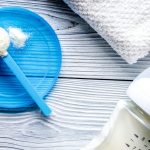 We’ve written a lot about breastfeeding, but we know there are reasons for parents to go the formula route. When it comes to storing, mixing and serving baby formula safely, the rules aren’t exactly straightforward. Formula comes in different forms (power, liquid concentrate, and ready-to-use) – all with slightly different guidelines. Luckily, once you get the hang of those guidelines, safe formula feeding becomes pretty simple.
We’ve written a lot about breastfeeding, but we know there are reasons for parents to go the formula route. When it comes to storing, mixing and serving baby formula safely, the rules aren’t exactly straightforward. Formula comes in different forms (power, liquid concentrate, and ready-to-use) – all with slightly different guidelines. Luckily, once you get the hang of those guidelines, safe formula feeding becomes pretty simple.
Highlights:
|
Let’s explore the do’s and don’ts:
Storing Formula
If you’re using powdered formula:
- Store unmixed formula in an air-tight container in a cool, dry place (avoid extreme temperatures, such as in the freezer or next to the stove).
- You can pre-mix powdered formula for later use, but it must be stored in the fridge and used within 24 hours.
If you’re using liquid concentrate or ready-to-use formula:
- Store unopened containers in a cool, dry place (avoid extreme temperatures, such as the freezer or stove).
- Store opened containers in the fridge and use within 48 hours.
- You can pre-mix liquid concentrate formula for later use, but it must be stored in the fridge and used within 48 hours.
Mixing Formula
Before Mixing
Before mixing formula (or feeding your baby ready-to-use formula), be sure the expiration date hasn’t passed. Also, talk to your child’s doctor before thickening formula with cereal or anything else. In some cases, thickening formula may help with infant reflux, but only with the green light from a doc.
Cleanliness
When it comes to sterilizing bottles, nipples and other bottle parts, expert advice varies slightly. Many say that for healthy babies you should sterilize bottles and parts just once: Before using them for the first time. Others, including the Center for Disease Control and Prevention, say for babies younger than 3 months (or for those born prematurely or with weakened immune systems), bottle parts should be sterilized once a day. If you’re unsure about whether regular sterilization is necessary, check in with your child’s doctor for guidance.
To sterilize bottle parts, simply submerge them in a pot of water, bring the water to a rolling boil, boil for 5 minutes, remove with tongs, and place on a clean drying rack. (This method is appropriate for most bottles and parts, but check the manufacturer’s instructions to be sure).
Aside from sterilization, bottle parts need to be thoroughly washed after each use with hot, soapy water and placed on a clean drying rack. Dedicated bottle and nipple brushes are a must for getting into crevices and ensuring bottle parts are squeaky clean.
Alternatively, if your bottle parts are dishwasher safe, you can wash them in a dishwasher with hot water and a heated drying cycle. No heated drying cycle? Be sure to remove bottle parts as soon as the dishwasher stops and transfer them to a clean drying rack. (It’s worth noting that the American Academy of Pediatrics recently advised parents to not wash plastic food containers in the dishwasher if possible.)
Lastly, before opening formula containers it’s a good idea to wash them. This helps keep any bacteria on the outside from getting inside. Also be sure your hands, prep area, and mixing utensils are clean.
Mixing
If you’re using powdered or liquid concentrate formula:
- Mix according to package instructions with water that’s safe to drink (you can find more information about safe water here).
- Be sure NOT to add extra water when mixing formula. It can disrupt the nutritional balance of the formula, and in some cases too much water can be dangerous for your baby.
If you’re using ready-to-use formula:
- No mixing required! Simply pour the desired amount into a bottle and it’s ready to go.
Serving Formula
Once you prepare a bottle, either feed it to your baby or pop it in the fridge within 1 hour. If you leave it out longer than that, harmful bacteria can grow.
Speaking of bacteria, it can also grow in formula that’s left in a bottle after feeding. If your baby doesn’t finish a bottle it can be tempting to pop leftover formula in the fridge and save it for later, but the safest thing to do is toss it.
You can serve formula cold, at room temperature, or warm, but experts say warming isn’t necessary. What’s more, if your baby gets used to warm formula that means an extra step for you before every feeding. If you want to go the warming route anyway, be sure NOT to warm formula in the microwave or on the stove, where it can easily overheat or heat unevenly. Instead, run the bottle under hot tap water, or submerge it in a bowl of hot (not boiling) water for a minute or two. Anytime you warm formula, shake a few drops on your wrist to test the temperature before giving it to your baby.
Now that you know the rules for safely storing, mixing and serving formula, you may have other questions, like how much to give your baby, or when to stop feeding her in the middle of the night. Head over here for answers to those questions and more.








